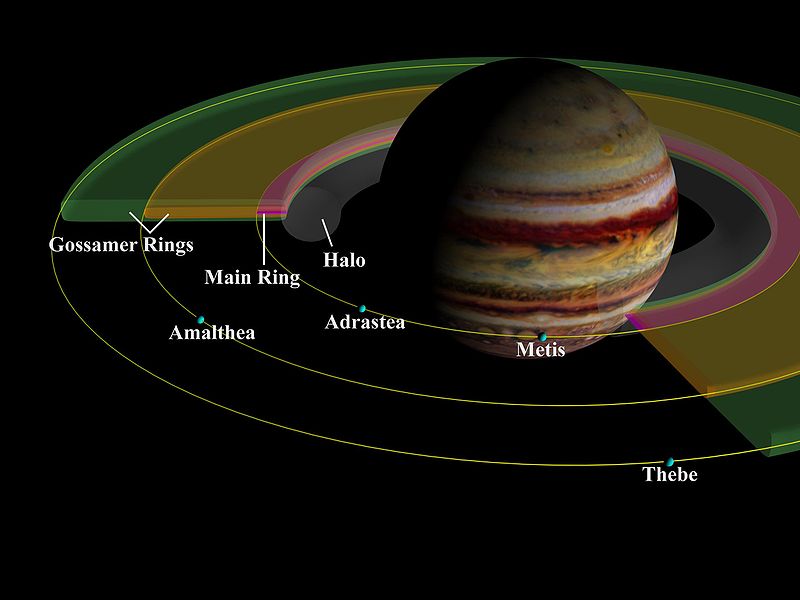The passage of the Voyager spacecraft near Jupiter has revealed new and surprising information regarding this planet. It turned out that he also has rings, although they are different in size and character from Saturn's rings. The Galileo that entered orbit around Jupiter and the passage of the two Cassini spacecraft on its way to Saturn and the New Horizon on its way to Pluto discovered new things about these rings

The passage of the Voyager spacecraft near Jupiter has revealed new and surprising information regarding this planet. It turned out that he also has rings, although they are different in size and character from Saturn's rings. The Galileo that went into orbit around Jupiter and the passage of the two Cassini spacecraft on its way to Saturn and the New Horizon on its way to Pluto discovered new things about these rings.
The information that came from Galileo combined with computer simulations showed that Jupiter had another ring. The distance of the ring from Jupiter is 1,126,000 km. The direction of its movement around Jupiter is opposite to that of its moons and the direction of Jupiter's movement around itself and its shape is like that of its moon. The ring is made of dust particles that are between 0.6-1.4 microns in size and that were captured by Jupiter's magnetosphere (1). The outer ring among the three discovered by the Voyagers, which was named the Gossamer ring due to its transparency, is actually made of two rings, one inside the other, and both are made of microscopic fragments originating from two small moons, Ethela and Thebes. It is estimated that the central ring is also made of small fragments and the origin of these in the moons Adrasta and Metis. Galileo transmitted to Israel 36 photographs of the rings and these 4 small moons. The surface of these moons is very strange, their color is red, their composition is unknown and the density of craters in them is high due to meteorite impact. The particles in the rings resemble red soot. Unlike Saturn's rings, there are no signs of ice in the rings.
According to the researchers' assessment, the dust is splashed from these moons when they are hit by meteorites or fragments of comets and asteroids. The ejected dust gathers high speed due to Jupiter's great gravity. At the time of impact, they penetrate deep into the soil of the moons, vaporize, explode and cause the dust and the splashed particles to move at such a high speed that they are released from the gravitational force of these moons and enter orbit around Jupiter (2).
The range of angles at which the xenon observed the main ring allows for the development of insights regarding the particles in the ring in terms of the way they scatter sunlight. The resulting impression is that these particles do not have a numerical shape. If there were books, most likely their origin was from the melted drops and not erosion. It is estimated that they originate from the surface of the small moons that have undergone a process of erosion that originates from the impact of micrometeoroids (3).
The New Horizon spacecraft discovered arcs and clumps of dust in the rings, indicating that they were recently hit by a small moon. A movie produced from the spacecraft's photographs provided an unprecedented look at the interaction between the rings and their accompanying moons Metis and Adrasta. These images show that the rings can develop quickly and the changes can be detected over a period of weeks and months. Similar phenomena have been observed in Saturn's rings (4).
One of the strangest and most interesting phenomena is that the expansion of the outer ring and other phenomena occur in the shadow region of Jupiter during their movement around it. The grains in the rings disintegrate and become electrically charged alternately as they pass through Jupiter's shadow region. These systematic changes in the electrical charge of the dust particles have a dynamic interaction with the planet's magnetic field. As a result, small dust particles are pushed outside the outer boundary of the ring and extremely small particles change their angle of inclination or the inclination of their orbit relative to the planet. Relying on a model built to explain the phenomenon, the claim was made that the particles in Saturn's rings are too large and heavy to be affected by this process (5).
Sources
1."New class of dust ring discovered around Jupiter" 3.4.1998
http://www.jpl.nasa.gov/galileo/status980403.html
2."Galileo finds Jupiter's rings formed by dust blasted of small moons" 15.9.1998
http://www.jpl.nasa.gov/galileo/status980915.html
3."Rising storms revise history of Jupiter's stripes" 10.3.2003
http://www.spacedaily.com/news/jupiter-clouds-03a.html
4."Pluto-bound new horizons provides new look at Jupiter system" 2.5.2007
Http://www.spacedaily.com/reports/Pluto_Bound_New_Horizons_Provides_ New_ Look_ At_ Jupiter _System_999.html
5."Scientist find rings of Jupiter are shaped in shadow" 2.5.2008
Http://www.spacedaily.com/reports/Scientist_Find_Rings_of_Jupiter_Are_Shaped_ In _Shadow_999.html

4 תגובות
PS, a meteoroid is a meteoroid
A meteoroid is a small asteroid that wanders through space.
A meteor is the trail left by a meteoroid when it enters the Earth's atmosphere.
A meteorite is the part of the meteoroid that reached the surface of the earth when it entered the earth.
What is a "meteoride"?
Life
I noticed that you repeat the name "Pluto" in your articles, despite the common spelling "Pluto", and I was interested in something?
Besides, the article is interesting and the ring that turns upside down sounds interesting. Is there an explanation for the phenomenon?